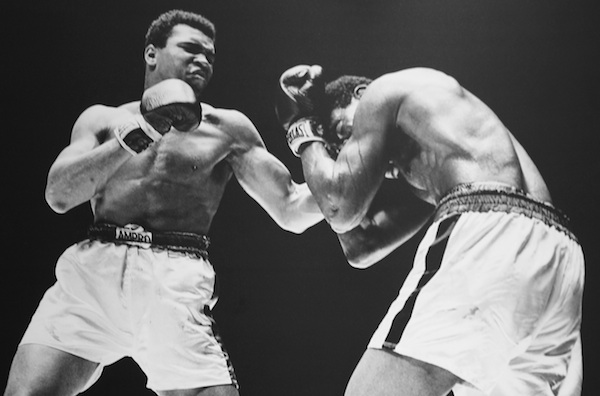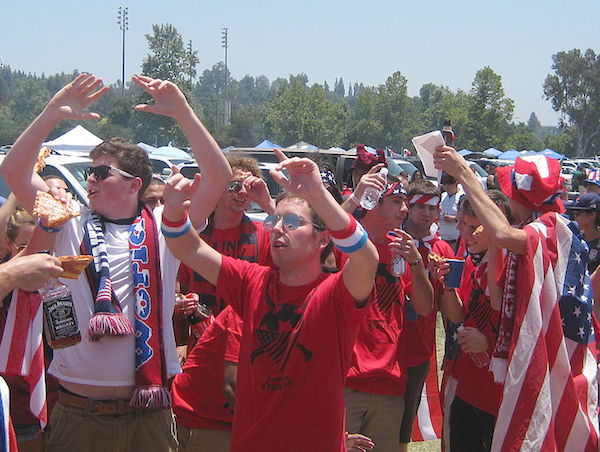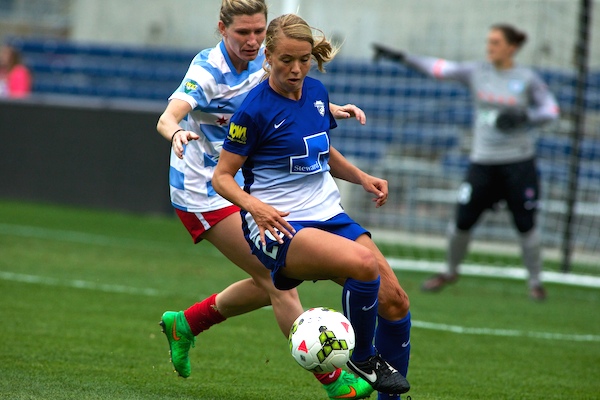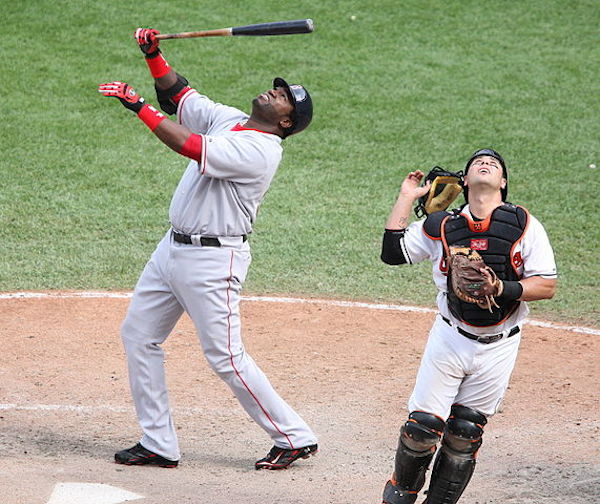The sports writer covering women’s sports has a problem. Write articles like people are used to reading about sports or about women? At Dear Sports Fan, we think the answer to that question should be to write articles about women’s sports the same way we would write about male sports. This isn’t to say that people should reduce female athletes to genderless passing, shooting, sweating sports-machines in order to be acceptable, but it does mean that articles which cover female athletes as women to such a degree that their athletic feats are reduced to an afterthought or forgotten entirely are bad. Sports writing that covers women’s sports but neglects the sports side of its subjects make the sports world as a whole less inclusive. One of Dear Sports Fan’s key goals is to make the sports world more inclusive. This is why we’ve been publishing gender-story-free player profiles of each of the members of the U.S. women’s national team in the lead up to the World Cup. It’s why I plunked down $12 to buy a copy of Equalizer Soccer’s 2015 World Cup preview. Unfortunately, not everyone agrees with our sports-first approach. I was disappointed by a recent issue of ESPN the Magazine that had so much promise but failed to deliver.
The June 8 edition of ESPN the Magazine showed up in my mailbox with a big picture of three members of the U.S. women’s national soccer team on the cover. With the World Cup in Canada quickly approaching, it makes sense for a sports magazine to focus on women’s soccer. I am extremely excited for the tournament. Not only is it an ideal subject for Dear Sports Fan but I’m personally invested in the U.S. team. I’ve followed them since what has unfortunately turned out to be their hey-day in the 1990s and am rooting for this group to reclaim the World Cup title after 16 years without one. I am hungry for knowledge about the upcoming tournament. Who is going to start? Who are the biggest threats to the American team? Are there any new up-and-coming players who could break out during the tournament like James Rodriguez and DeAndre Yedlin did last summer in the Men’s World Cup? I want to know all of that stuff. So, imagine my disappointment when I read the first paragraph of the first article about women’s soccer in the magazine: The Authentication of Alex Morgan by Janet Reitman.
Alex Morgan breezes into a Kansas City restaurant called Cafe Gratitude one early spring day looking perfect. Morgan is one of those people who can pull off appearing well-groomed even when drenched with sweat, and today she is casually, yet impeccably, attired in a long gray skirt, a black-and-white short-sleeved shrug and a white tank top, all of which she threw on after realizing she was half an hour late. She apologizes; she was trying to curl her hair. “I don’t know where my blow dryer is,” she says. There was also a minor crisis with her skirt, which apparently at some point was a crumpled mess. “I put it in the dryer for five minutes because we don’t have an iron yet.”
Okay, what? Alex Morgan is one of the key players on the U.S. team and, going into the World Cup, one of the biggest mysteries. She’s a star striker, who has been identified by many as the obvious goal-scoring successor to living legend Abby Wambach. Unfortunately, her last two years have been riddled with injuries and she’s missed most of the team’s recent games with a knee injury. A fully healthy Morgan would be a big part of the U.S. team but her health is questionable. She’s also more easily replaced than other stars on the team. Sydney Leroux provides a reasonable facsimile of Morgan and Amy Rodriguez or Christen Press could also step into her position. There’s so much good sports coverage to be had here but instead we get an introduction that focuses solely on Morgan’s appearance while also suggesting that she is ditzy in a stereotypically female way.
I move on to the second (and only other) article in the magazine about women’s soccer. This is an article about Hope Solo, the team’s long-time starting goalie. By Allison Glock, its headline is “Pride. Regret. Hope.” The article begins with a description of Solo’s home in Kirkland, Washington. We get a description of Solo’s “tasteful living room,” learning that it is “tidy, inviting” with its “plush beige couches” and “throw blankets [that] are draped over armrests.” Okay… We get a description of Solo, who is:
Tinier than you imagine. Lean, compact. The planes in her angular face catch what little light Seattle has to offer, her hair a Breck-girl wonder, her teeth white as the queen’s gloves.
When we hear from Solo herself, her first two quotes are about her husband, Jerramy Stevens. The first is, “He’s the neat freak.” The second, “I can’t even leave anything on the stairs.” Within four paragraphs, we have a description of Solo’s appearance, with reference to classic 1950s era shampoo ads, a description of her house which sounds like it comes out of an interior design article, and Solo herself speaking only about her husband. This article doesn’t even pass the Bechdel test so far!
All right, before we get carried away too far in our indignation about gender equality, there are some ameliorating circumstances and I am by no means out to hammer the two authors.
First, this is a magazine; a paper magazine. So, its articles have to be written and prepped far in advance. It can’t compete with websites in terms of newsworthiness, so it doesn’t try. Profiles are therefore a reasonable approach to take and the magazine frequently runs profiles of male athletes that also focus on their personal lives to some extent.
The second issue is the choice of subjects. The focus on Hope Solo’s family life is a legitimate, hard news focus because of a legal history that involves domestic abuses charges among other things. Of all the U.S. women’s soccer players, Alex Morgan has the most consciously constructed image. Her image is so carefully constructed that it’s hard to imagine writing about her without examining it. Solo and Morgan are both celebrities as well as athletes. Reitman recognizes this in her article when she writes:
If Hope Solo, with her complex personal life and frequent outbursts, is perceived as the Dark Queen in women’s soccer, then Alex Morgan is Snow White.
This is a hysterically accurate representation of how Morgan and Solo are viewed. So then, why choose those two? There are 21 other players on the team. Abby Wambach is the greatest goal scorer in international soccer history, men’s or women’s. Julie Johnston is a young player who is expected to play a major role on the team. Christie Rampone will be playing in her fifth World Cup. Why not profile athletes who are less set in the cultural understanding?
Admittedly, women’s sports is an active battleground in the gender-equality culture war, and its athletes consciously or unconsciously make and are seen as making statements about gender all the time. Ignoring the issue of gender completely (as I’ve chosen to do in my profiles) is sticking your head in the sand a little. As the articles go on, both authors make very clever and insightful comments about the diverging pressure women athletes are under to be feminine and win. Here is Reitman on Morgan:
Morgan has her own list of contradictions that don’t make her any less authentic: waving the flag for tween body image but contemplating breast implants; wanting her sport to be taken seriously while consciously leveraging her looks to attract male viewers…
In her article on Solo, Glock uses a quote from Solo’s teammate Carli Lloyd to describe the plight of being a world-class female athlete.
Lloyd has “felt pressure to be a certain kind of girl.” She too chafes at the double standard for women in sports, finding the impetus exhausting, if not impossible, to be sweet and approachable, to sand down every edge, to exist in a state of constant gratitude. “We live in a world where hair color and taking bikini selfies is more vital than stats,” sighs Lloyd, noting, “You can get shafted if you don’t play.”
The sad truth is that Lloyd is right. She has gotten shafted. She doesn’t construct a gendered image of herself as carefully as Morgan does or as Solo once tried to do, so she doesn’t get profiled in ESPN the Magazine. The editors of the magazine chose to focus on Solo and Morgan for a set of reasons. Their conventional attractiveness, enormous social media following, and status as known quantities in the culture were all part of that choice and all defensible to some extent. That’s kind of the problem with these types of social issues. A series of tiny defensible choices lead to the production of articles that focus almost exclusively on women’s athletes as women, not as athletes. That’s a shame.
I don’t mean to pick on ESPN. Some of their work has been excellent. ESPNW, its female focused branch provides consistently good coverage of the team. The Louisa Thomas profile of Sydney Leroux on Grantland was excellent and even better is the series of articles about leading players from other country’s teams by Allison McCann. Five Thirty Eight, another ESPN property, is doing a statistical model of the World Cup just like they did for March Madness and other sporting events, male and female. In fact, this model was the only piece in the magazine aside from these two profiles to focus on the World Cup and it gives the U.S. a slight edge over Germany as the favorites to win it all.
I hope the team does win the World Cup, and if they do, I hope it nudges us a tiny bit closer to a world where we cover athletes the same way, regardless of gender. The U.S. women’s national soccer team plays its last warm-up game before the World Cup today against Korea at 4:30 p.m. ET. The game will be televised live on ESPN. If you’re looking for less gendered coverage of the team and the World Cup, (aside from this site, of course) I suggest purchasing a copy of Equalizer Soccer’s 2015 World Cup preview. Led by editors Jeff Kassouf and Ann Odong, this beautifully written and produced preview is chock full of coverage that’s sports focused.









